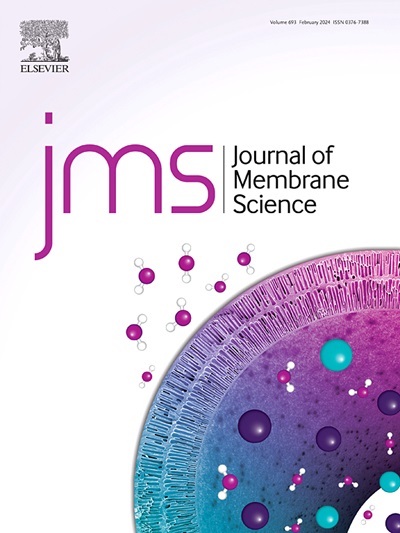聚合物共混物的多孔膜及其作为电化学电池功能隔膜的应用
IF 8.4
1区 工程技术
Q1 ENGINEERING, CHEMICAL
引用次数: 0
摘要
该作品探索了结合两种聚合物的多孔膜概念的合成:一种具有构成膜支架的结构作用,另一种具有在孔和膜表面形成特殊液体的聚合物凝胶的能力。在液体渗透后,结构聚合物在很长一段时间内保持膜的力学性能和尺寸稳定性不变,即不膨胀,而可溶性聚合物在孔隙和膜表面形成凝胶。在这项工作中,这些膜的目标是成为一种功能性分离器,能够在电化学电池中浸泡液体电解质后通过原位凝胶形成半固体电解质。这种功能分离器可以在不改变电化学电池工业过程的情况下形成半固态电解质,并避免在工业规模上处理超高分子量凝胶。采用非溶剂诱导相分离(NIPS)工艺制备了以聚碳酸酯(PC)为结构支架,以超高分子量(UHMW)聚氧聚乙烯(PEO)为可溶性聚合物的原位凝胶功能分离器。聚合物的分布、孔隙形态取决于实验条件,特别是混凝前PC/PEO的混合程度。聚合物的分布允许在PC支架的孔隙处形成PEO凝胶,从而将超高分子量聚合物凝胶电解质的电化学性能与PC的耐化学性和机械性能结合起来。此外,PEO的存在使PC支架(否则是疏水的)与亲水性电解质(如含水的ZnCl2, Zn共晶乙酰胺Zn(TFSI)2 (ACE-Zn)和氯铝酸盐乙酰胺- alcl3)润湿,在这项工作中选择,以展示分离器的多功能性,它们在电解质中浸泡数月后不会膨胀,破裂或降解。采用电解液ACE-Zn分别浸泡在PC/PEO膜(40 μm)和玻璃纤维分离器(100 μm)中,构建了对称Zn||锌电池。后者在150次循环前就发生了短路,而功能分离器在300次循环后没有发生短路,这证明了在功能分离器处形成了超高分子量PEO凝胶,并增加了循环稳定性,突出了该方法的成功。本文章由计算机程序翻译,如有差异,请以英文原文为准。
Porous membranes of polymer blends and their use as functional separators for electrochemical batteries
This works explores the synthesis of a porous membrane concept combining two polymers: one with a structural role which constitutes the scaffold of the membrane, and the other with the capacity to form a polymer gel with ad-hoc liquids at the pores and surface of the membrane. After liquid infiltration, the structural polymer keeps the mechanical properties and dimensional stability of the membrane constant, i.e. no swelling, for long time periods, while the soluble polymer forms a gel at the pores and membrane surface. In this work, the goal of these membranes is that of a functional separator able to produce semisolid electrolytes by in-situ gel formation upon soaking with liquid electrolytes at electrochemical cells. This functional separator enables the formation of the semisolid electrolyte without modification of the electrochemical cells industrial processes, and avoiding the handling of UHMW gels at an industrial scale. Functional separators comprising polycarbonate (PC) as the structural scaffold and ultrahigh molecular weight (UHMW) polyethylene oxide (PEO) as the soluble polymer for in-situ gel formation are prepared by adapting the non-solvent induced phase separation (NIPS) process to the simultaneous coagulation of the two polymers. The polymer distribution, pore morphology depend on the experimental conditions, especially on the PC/PEO degree of mixing before coagulation. The polymer distribution permits the formation of PEO gel at the pores of the PC scaffold, thus combining the electrochemical properties of UHMW polymer gel electrolytes, with the chemical and mechanical resistance of PC. Moreover the presence of PEO enables the wetting of the PC scaffold (otherwise hydrophobic) with hydrophilic electrolytes such as aqueous ZnCl2, the Zn eutectic acetamide Zn(TFSI)2 (ACE-Zn) and the chloroaluminate acetamidine-AlCl3, selected in this work to showcase the separators’ versatility, which do not do not swell, break, or degrade after months soaked in the electrolytes. Symmetric Zn||Zn cells were built using the electrolyte ACE-Zn soaked in PC/PEO membranes (40 μm) and in a 100 μm glass fiber separator. While the latter short-circuited before 150 cycles, functional separators endured 300 cycles with no short-circuiting, proving the formation of the UHMW PEO gel at the functional separators and concomitant increase in cycling stability, highlighting the success of this approach.
求助全文
通过发布文献求助,成功后即可免费获取论文全文。
去求助
来源期刊

Journal of Membrane Science
工程技术-高分子科学
CiteScore
17.10
自引率
17.90%
发文量
1031
审稿时长
2.5 months
期刊介绍:
The Journal of Membrane Science is a publication that focuses on membrane systems and is aimed at academic and industrial chemists, chemical engineers, materials scientists, and membranologists. It publishes original research and reviews on various aspects of membrane transport, membrane formation/structure, fouling, module/process design, and processes/applications. The journal primarily focuses on the structure, function, and performance of non-biological membranes but also includes papers that relate to biological membranes. The Journal of Membrane Science publishes Full Text Papers, State-of-the-Art Reviews, Letters to the Editor, and Perspectives.
 求助内容:
求助内容: 应助结果提醒方式:
应助结果提醒方式:


